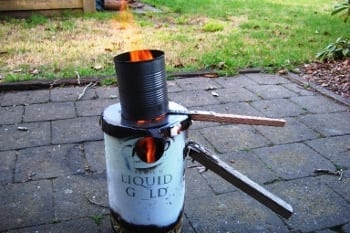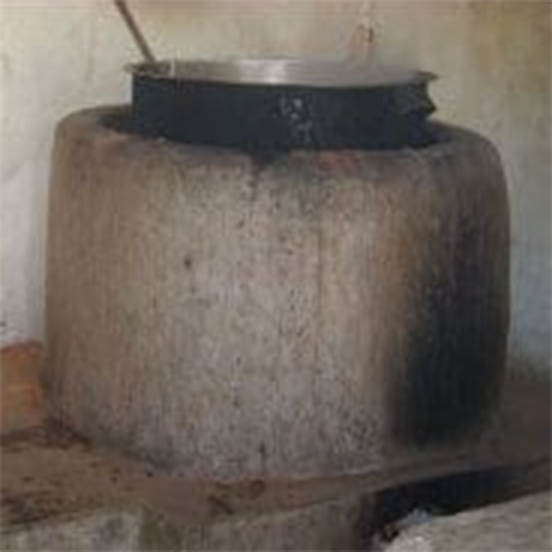We are glad to see another novelty in efficient stoves: dung burners. Students at the Univeristy of Adelaide, Australia, turned their problem-solving minds to the dung-burning fires kitchens of Nepal’s Terai region and developed a clean-burning stovespecialized for that unusual fuel. In the absence of woody forests, dung from livestock is only option in the region. But open dung-burning cook fires are a health hazard just like a wood fire. Streamlining the stove can add years to cooks’ lives and reduce the amount of fuel needed.
“Our challenge is to use the right mix of technology and to make it accessible to those who need it,” says Greg Macfarlane, a student involved in the project. “We have designed the stoves to minimize costs, and local manufacture has always been the goal.”

Photo courtesy of Gregory Macfarlane
Working from a supply of 40 empty paint cans donated from the local Solver Paints store, the students are building and testing prototypes in Adelaide. One is the Top-Lit Up Draft (TLUD), a micro-gasifier that converts dung into biochar and performs well in emissions tests. Micro gasifiers are clean-burning designs that have emerged in the last decade. They allow smoke rising from the fuel to gather in a separate combustion chamber where the smoke burns to produce heat. HEDON Household Energy Network provides a useful micro-gasifier overview.
“Not only does the cookstove produce a much cleaner flame than traditional means, it also has a by-product of bio-char, which can be used as a soil enhancer,” Cristian Birzer, a senior research associate at the university who co-supervises the stove development, told E4C.
The other design is a portable Pre-Heated Improved Rocket (PHAIR) stove that burns dung and wood. Pending the results of their tests, however, the benefit of pre-heating is still in doubt. The students are not afraid to put their ideas on the chopping block. They have already shelved a third, fan-powered design that didn’t pass muster.
The test line up is simple: The stoves boil water while the students measure their efficiency and emissions. Then the students compare their prototypes to traditional stoves.
“This is an important challenge for our project, as many so-called improved stoves fail to provide benefits in crucial areas such as indoor air pollution or fuel efficiency,” Macfarlane says. They will pass their working prototypes onto Engineers Without Borders volunteers working in Nepal for field tests.

Photo courtesy of Gregory Macfarlane
The dung difference
The Adelaide team has intimate knowledge of dung. They have washed it, sifted it with gloved hands, made it into a slurry to find out if it burns more cleanly with impurities removed and tested its burning efficiency. For proof of their commitment, see their video blog “All things dung,” linked below.
Dung contains only two-thirds of the energy in wood, so to accommodate, Macfarlane and company have expanded the combustion chamber in their TLUD.
“Before this project, I wouldn’t have thought cow dung would burn, however our stoves have reached over 600°C,” Macfarlane says.
Why another stove design?
There may be hundreds of stove designs strewn throughout the Internet and rural kitchens. Some of them are here in ourSolutions Library. The appeal is that they work. They solve real health and environmental problems.
The spotty distribution of fuel sources demands that for stove design, as in micro power generators, variety is key. About half of the world’s population burns biomass in their kitchens. As the students put in an email to E4C, “We have discovered there is no single stove solution for 3 billion consumers.”
The wide-open field of stove design is more evidence that the Wild West ethos runs strong in humanitarian technology. We venerate the mavericks and outlaws of design, and the work is still gritty and deeply DIY. There’s exciting variety in technologies, from household power generators to mobile health apps. And, of course, efficient stoves.
Prototyping video logs
The video at left is the first in a series of video logs that the students made to document their experimentation. They are “Make It So” ideas, part of a humanitarian technology development initiative by Engineers Australia. Links to the other vlogs follow:
Make It So idea – Optimisation of cooking stoves – Blog 2 – All things dung
Make It So idea – Optimisation of cooking stoves – Blog 3 – Traditional stove test
Make It So idea – Optimisation of cooking stoves – Blog 4 – Dung burning in a TLUD
This is the roster of students and faculty involved in the stove designs, some of whom you’ll see in the videos above.
- Matthew Higgins
- Greg Macfarlane
- Matthew Read
- Josh Wilkey
- Tomas West
- Supervisor: Dr. Paul Medwell
- Co-supervisor: Dr. Cristian Birzer
Related news
How to build a wood-burning institutional stove
Clean stoves charge electronics and ease global warming
How a loudspeaker in a cookstove can power electronics and cut pollution


